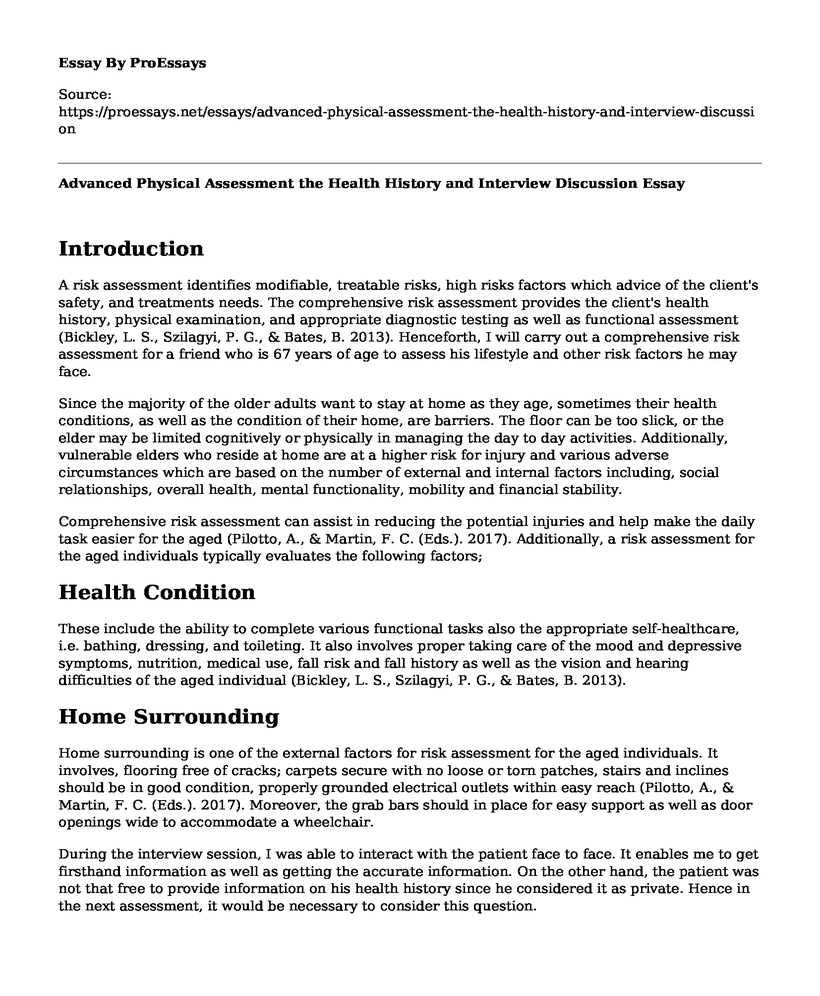Introduction
A risk assessment identifies modifiable, treatable risks, high risks factors which advice of the client's safety, and treatments needs. The comprehensive risk assessment provides the client's health history, physical examination, and appropriate diagnostic testing as well as functional assessment (Bickley, L. S., Szilagyi, P. G., & Bates, B. 2013). Henceforth, I will carry out a comprehensive risk assessment for a friend who is 67 years of age to assess his lifestyle and other risk factors he may face.
Since the majority of the older adults want to stay at home as they age, sometimes their health conditions, as well as the condition of their home, are barriers. The floor can be too slick, or the elder may be limited cognitively or physically in managing the day to day activities. Additionally, vulnerable elders who reside at home are at a higher risk for injury and various adverse circumstances which are based on the number of external and internal factors including, social relationships, overall health, mental functionality, mobility and financial stability.
Comprehensive risk assessment can assist in reducing the potential injuries and help make the daily task easier for the aged (Pilotto, A., & Martin, F. C. (Eds.). 2017). Additionally, a risk assessment for the aged individuals typically evaluates the following factors;
Health Condition
These include the ability to complete various functional tasks also the appropriate self-healthcare, i.e. bathing, dressing, and toileting. It also involves proper taking care of the mood and depressive symptoms, nutrition, medical use, fall risk and fall history as well as the vision and hearing difficulties of the aged individual (Bickley, L. S., Szilagyi, P. G., & Bates, B. 2013).
Home Surrounding
Home surrounding is one of the external factors for risk assessment for the aged individuals. It involves, flooring free of cracks; carpets secure with no loose or torn patches, stairs and inclines should be in good condition, properly grounded electrical outlets within easy reach (Pilotto, A., & Martin, F. C. (Eds.). 2017). Moreover, the grab bars should in place for easy support as well as door openings wide to accommodate a wheelchair.
During the interview session, I was able to interact with the patient face to face. It enables me to get firsthand information as well as getting the accurate information. On the other hand, the patient was not that free to provide information on his health history since he considered it as private. Hence in the next assessment, it would be necessary to consider this question.
References
Bickley, L. S., Szilagyi, P. G., & Bates, B. (2013). Bates' guide to physical examination and history-taking. Philadelphia: Wolters Kluwer Health/Lippincott Williams & Wilkins.
Pilotto, A., & Martin, F. C. (Eds.). (2017). Comprehensive geriatric assessment. Springer.
Cite this page
Advanced Physical Assessment the Health History and Interview Discussion. (2022, Jul 14). Retrieved from https://proessays.net/essays/advanced-physical-assessment-the-health-history-and-interview-discussion
If you are the original author of this essay and no longer wish to have it published on the ProEssays website, please click below to request its removal:
- Business Negotiation/Deal Making
- Essay on Causes of Obesity in Children
- Essay Sample on Nursing: An Underrated Yet Fulfilling Profession
- Essay Example on Abortion Debate: Right or Wrong?
- Essay Sample on The Galveston Bay Disaster: Examining Negligence & Regulations
- Inquisitive and Courageous: How to Protect From Coronavirus - Essay Sample
- Essay Example on Drug Use & Off-Label Prescriptions in Children: Risking Health?







